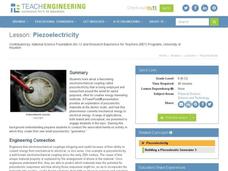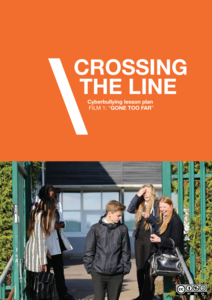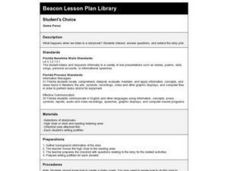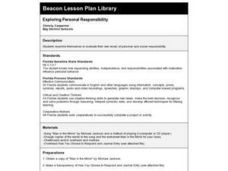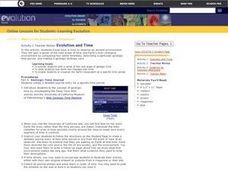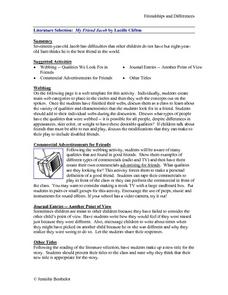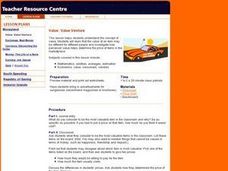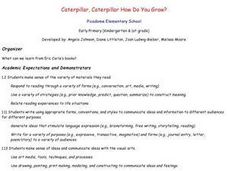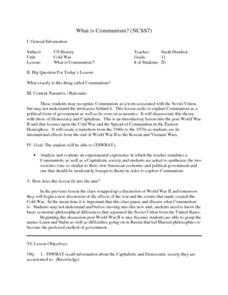EngageNY
Rational and Irrational Numbers
Back to the basics: learning how to add numbers. The 17th installment of a 35-part module first reviews addition techniques for rational numbers, such as graphical methods (number line) and numerical methods (standard algorithm). It goes...
Teach Engineering
Capillarity – Measuring Surface Tension
How do cohesion and adhesion work together? The third installment of a nine-part series teaches young scientists the difference between adhesion and cohesion. They also learn how cohesion and adhesion work together to cause capillary...
TryEngineering
Sorting Socks is Algorithm Complexity
Use hosiery to teach computer science. Scholars use socks to develop a set of algorithms. They find ways to find a particular sock from a set and ways to sort socks. Finally, they use their algorithms to consider time complexity.
Teach Engineering
Piezoelectricity
What effect makes children's shoes light up? Answer: Piezoelectric effect. Here is a PowerPoint presentation that describes piezoelectric materials as being able to convert mechanical energy to electrical energy. Individuals learn how...
Childnet International
Crossing the Line: Cyberbullying
Members of the LGBTQ community are more likely to be bullied online than their peers—and bystanders who do nothing can be as problematic as the bullies themselves. Middle schoolers explore ways to protect themselves and others on the...
National Endowment for the Humanities
The New Order for "Greater East Asia"
Sometimes the New Order becomes synonymous with its implications for European countries, but what about its consequences for East Asia? The final instructional activity in a four-part series teaches scholars about World War II. High...
Chicago Botanic Garden
Reflecting on What I Learned About Climate Change
After three eye-opening lessons about our environment, scholars revisit a 10-question survey, reflect on their new-found knowledge, and take action by writing to a representative or creating a public service announcement about...
Curated OER
Charlotte's Web
Fourth graders focus on fluency by reading the book Charlotte's Web. In this reading strategies instructional activity, 4th graders partner read, do guided reading, and independent reading to increase fluency. Students use Venn...
Curated OER
STUDENT'S CHOICE
Students interact, answer questions, and extend the story plot. They write a Haiku or basic poetry with their words, name characters, create a new ending for a story, and write a new story with one of the characters.
Curated OER
Journaling Art
Students write in daily journal. Using computers, students keep the journal in spreadsheet form. They research facts on given artists. At the end of the six-week term, students are tested over the artist.
Curated OER
Bridge Design
Students use "Interactive Physics Program" to develop a bridge similar to their physical model. They may choose to redesign their bridges completely. They design a simulation that test the amount of stress their bridge can withstand.
Curated OER
Treasure Hunt
Pupils find lost "treasure" using a treasure map after being shown a map that you have created where terms and symbols are discussed. The class is divided into small groups where they locate your treasure and then read a section from...
Curated OER
Reflections of a Different Time; Pilgrim Children
Pupils create a reflective journal entry on the lives of Pilgrim Students.
Curated OER
Beginning Your Journal
Students develop a deeper awareness of the use of journals and gather inspiration to begin their journal from their graphic time lines. They explore, ponder, test and illustrate self-expression through daily journal writing. Each student...
Curated OER
Exploring Personal Responsibility
Third graders examine themselves to evaluate their own levels of personal and social responsibility. They read the lyrics to 'The Man in the Mirror' and compose journal entries about personal responsibility.
Curated OER
Moby-Dick
Students take on the persona of a sailor or a captain of a whaling vessel in New England in the 1800s and write five journal entries as that person. In this Moby Dick instructional activity, students research the whaling...
Curated OER
Happy Birthday, Earth!
Students visualize the Earth's ecosystem at a specific time period and how Earth has changed over time. They create a detailed journal entry for a specific time period and create a birthday card to Earth.
Curated OER
Friendships and Differences
Students complete a variety of activities related to the book "My Friend Jacob" by Lucille Clifton. They complete a graphic organizer web about friendship qualities, and participate in a discussion about friendship. In small groups...
Curated OER
Lessons in Loss, Year of Impossible Goodbyes
Students determine how the Korean people dealt with the loss of their land and traditional lifestyle in response to invasion and emigration. They create a list of items and people they have lost. From this they complete a journal...
Curated OER
Why Plants Are Important to Us
First graders explore plant life. In this plant lesson, 1st graders examine various plant life and categorize them. Students graph their data and make journal entries regarding their work.
Curated OER
Value Venture
Learners examine how the value of an item may be different for different people and investigate how perceived value helps determine the price of items in the marketplace. They list what they consider to be the most valuable items in the...
Curated OER
Caterpillar, Caterpillar How Do You Grow?
Students work in small groups of three or four to create books based on the Eric Carle books studied. Topics may include tadpoles, guppies, people, moths, and plants. Media used may include Kid Pix, sound recordings, art pieces,...
Curated OER
Environmental Fair for our St. Mary¿¿¿s River
Students list sources of pollution and their effects on the St. Mary River environment. They discuss how pollution may effect the environment and draw up a list of possible types of pollution.
Curated OER
What is Communism?
Eleventh graders explore Communism. They explore Communism's roots in economics and discuss the spread of Communism in the Eastern Hemisphere. They evaluate a Communistic and a Capitalistic society. Students reflect upon the positives...



